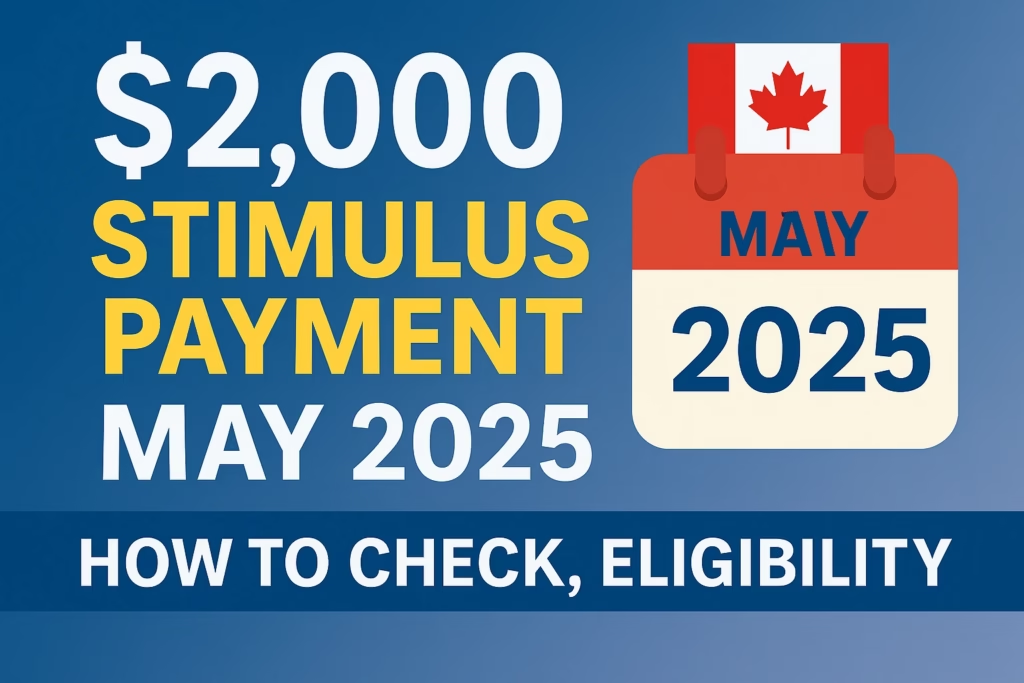As the cost of living continues to rise in 2025, many individuals and families across North America are looking for financial relief. The latest $2000 stimulus payment rolling out in May 2025 aims to provide just that. Whether you’re already expecting this payment or still wondering if you qualify, this article covers everything you need to know—from eligibility requirements to how to check your payment status, and a clear explanation of what a stimulus payment actually is.
What Is a Stimulus Payment?
A stimulus payment is direct financial support provided by the government to its citizens during economic hardships. It’s designed to “stimulate” the economy by putting money directly into people’s pockets so they can spend on essentials—housing, food, utilities, transportation, and more.
Stimulus checks became widely known during the COVID-19 pandemic, when countries like the United States and Canada issued multiple rounds of payments to help people get through lockdowns and job losses. In 2025, a similar approach is being taken to combat inflation, rising interest rates, and increased cost of living.
$2000 Stimulus Payment May 2025 – What’s Happening?
The $2000 stimulus payment in May 2025 is a targeted financial aid initiative by the government to help eligible citizens manage high living expenses. Unlike previous one-size-fits-all stimulus checks, this payment is focused on low to middle-income families, seniors, and those receiving benefits.

Why May 2025? Perfect Timing for Financial Relief
The May 2025 rollout isn’t random—it’s a strategic move by governments to:
Beat Summer Budget Crunch
- Summer brings higher costs (travel, childcare, AC bills). This payment helps families get ahead before expenses spike.
Leverage Fiscal Surpluses
- Both the U.S. and Canada are using unexpected budget surpluses (thanks to post-pandemic recovery) to fund this aid—your tax dollars at work.
Counter Inflation Pressures
- With grocery and gas prices still volatile, the timing acts as a targeted inflation buffer—putting money where it’s needed most
Who Is Eligible for the $2000 Stimulus Payment?
Eligibility varies slightly based on the country (U.S. vs Canada), but in general, recipients must meet these core criteria:
General Eligibility (Applies to Most Provinces/States):
- Be 18 years or older
- Be a resident or citizen of the country issuing the payment
- Have filed taxes for 2023 or 2024
- Earn below a specific income threshold (varies by location)
- Not be claimed as a dependent by someone else
Income Limits (Estimated for 2025):
- Single individuals earning up to $75,000/year
- Married couples earning up to $150,000/year
- Heads of household up to $112,500/year
If you receive government benefits such as:
- Employment Insurance (EI)
- Social Security (US)
- Old Age Security (Canada)
- Disability benefits (SSDI/CPP-D)
…you may automatically qualify, even if you don’t regularly file taxes.
How to Check If You’ll Receive the $2000 Payment
1. Check Government Portals
- U.S. Residents: Visit irs.gov and use the “Get My Payment” tool.
- Canadians: Visit CRA My Account and check for recent payments or updates under “Benefits and Credits.”
2. Monitor Bank Accounts
If you’re enrolled for direct deposit, your payment may already be scheduled or processed. Check your banking app for any deposits from the CRA (Canada) or IRS/Treasury (USA).
3. Wait for a Paper Check or Prepaid Card
If you haven’t signed up for direct deposit, payments will be issued via cheque or a government-issued prepaid card. These often take 1–3 weeks longer.
What If You Didn’t File Taxes?
Don’t file taxes? You may still qualify for the $2000 stimulus! Seniors, disability recipients, and low-income individuals can register through special programs. In the U.S., use the IRS Non-Filers Tool (income under $12,550 single/$25,100 married). Canadians can access CRA’s Auto-Fill service or call 1-800-959-8281 for OAS/GIS recipients. Registering ensures you receive your full payment, qualify for future aid, and avoid delays. While not required to file, submitting your information is quick and protects your benefits. Act soon – deadlines may apply for non-filer submissions. This ensures financial support reaches those who need it most, regardless of tax filing status.”
- Canada: Use “Auto-Fill My Return” via CRA or NETFILE
- USA: Use the Non-Filers: Enter Payment Info tool on IRS.gov
Will This Affect My Benefits or Taxes?
No. The $2000 stimulus payment is:
- Not taxable (won’t increase your income)
- Won’t reduce your eligibility for other government support
- Not repayable
You can spend it however you want, whether it’s rent, groceries, debt repayment, or saving for the future.
How This Stimulus Payment Helps the Economy
When millions of people receive money at once, and they spend it on local businesses, essentials, or bills, it helps stimulate economic growth. It’s a proven strategy to:
- Boost consumer spending
- Support small businesses
- Reduce debt defaults
- Stabilize the housing and rental markets
Frequently Asked Questions
Direct deposit payments started rolling out in early May 2025. Paper cheques and prepaid cards are expected by mid to late May.
Update your information with the CRA (Canada) or IRS (USA) as soon as possible to avoid delays.
Currently, this is the only announced payment. However, more may follow based on economic indicators and government decisions.
Final Thoughts
The $2000 stimulus payment in May 2025 is a lifeline for millions navigating the challenges of rising costs. Whether you’re paying bills, managing debt, or just trying to make ends meet, this payment can help ease the burden.
Stay updated by checking official websites like the IRS.gov (U.S.) or Canada.ca (CRA), and make sure your information is current to avoid delays. More than ever, staying informed and financially prepared is your best bet in 2025.